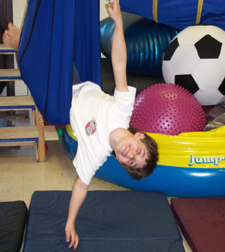
|
Pediatric Occupational, Physical, ABA/Behavioral, Feeding, Speech, and Language Therapies Main Clinic: 931-372-2567 1445 East 10th Street Cookeville, TN 38501 Email: [email protected] HIPAA Secure Email: [email protected] Fax: (931) 372-2572 ABA Clinic: 931-201-9534 400 Dubois Road Cookeville, TN 38501 Email: [email protected] Please call today to get started! Most insurances accepted! |

|
| Who needs therapy? | SE HABLA ESPAÑOL |
Ribcage Mobility
Rib Cage Mobility
Many therapists and doctors forget about the muscles between the ribs. These muscles must be stretched and moved with passive range of motion exercises in order to help with trunk rotation, trunk extension, scapula and shoudler range of motion.
Many babies and children, especially those with limited movement in the early months, prematurity, or tonal issues develop shortened muscles or tight muscles between the rib cage. These muscles are called the INTER-COSTALS and there are 3 sets.
Tight rib cages and rib flaring can cause difficulty with trunk mobility, postural control, respiratory and vocalizations difficulties.
Rib cage mobility exercises can be done as often as possible, as you are just helping the muscles to stretch and lengthen, and then facilitating more movement once some relaxation and elongation is achieved.
They can be done while the child is on their belly (prone), laying on their back (supine), over a therapy ball prone or supine, and some exercises are done in sitting.
It is also a good deep pressure massage input to help calm the sensory input and increase skin to skin contact which is very important especially the first year of life.
~ Perform about 2 hours after a meal, create a calm environment, with warmer temperatures, warm hands, nonscented massage lotion if desired, warm towels or blanket from the dryer (lay over therapy ball as balls are usually cold), calming music
Lateral Movements are done first, as developmentally these are the first movements of the rib cage as babies play in prone...
Lateral Movements
Place your warm hands on each side of chest, under the armpit. Move your hands in a side to side movement (lateral). You are loosening up the ribcage muscles.
After several movements (at least 5 each side) with a side to side motion and some downward pressure, then move your thumb down one rib and repeat.
The ultimate goal is to promote lateral and downward movements of the space between the ribs, the intercostal muscles and free up movement between the ribs.
Downward Movements
This may also be done on belly, back, or sitting...
This is a deeper input than lateral, you want to feel the bony structures...
Place your hands on the lateral aspects of ribs starting with thumbs parallel with lowest rib and fingers on sides. Purpose of this is to break up the "holding" positions and lengthen the intercostalis.
*Begin with lower ribs with downward and lateral movements. You have to make space for the higher ribs to come down. Start low and move up with a deeper pressure than before.
Freeing up Posterior and Anterior Ribcage
Purpose is to free up the chest wall and encourage more diaphragmatic breathing.
Posterior: Place each hand on either side of the spine, with thumbs near the center spine and fingers fanned outward. Move hands outward giving light to medium pressure down and out. Lengthen, hold, lengthen, then move out and down.
Once hands are closer to side of chest then give more lateral movements. Move down and repeat.
Anterior: same as posterior, except hands are on each side of sternum. With smaller infants, only one hand is needed over the sternum. Move side to side and downward.
Trunk Elongation and Rotation
The child must have some lateral weight shift and protective extension to the side...
In supported sitting, behind the child, You can place one hand on rib from behind with pressure given downward, with your trunk and body support and other hand you give lateral weight shift input to opposite side that you are massaging. You can facilitate rotation after you give downward pressure. Place toy on side you are wt. shifting to... Repeat on other side
Site empowered by
WebOnTheFly